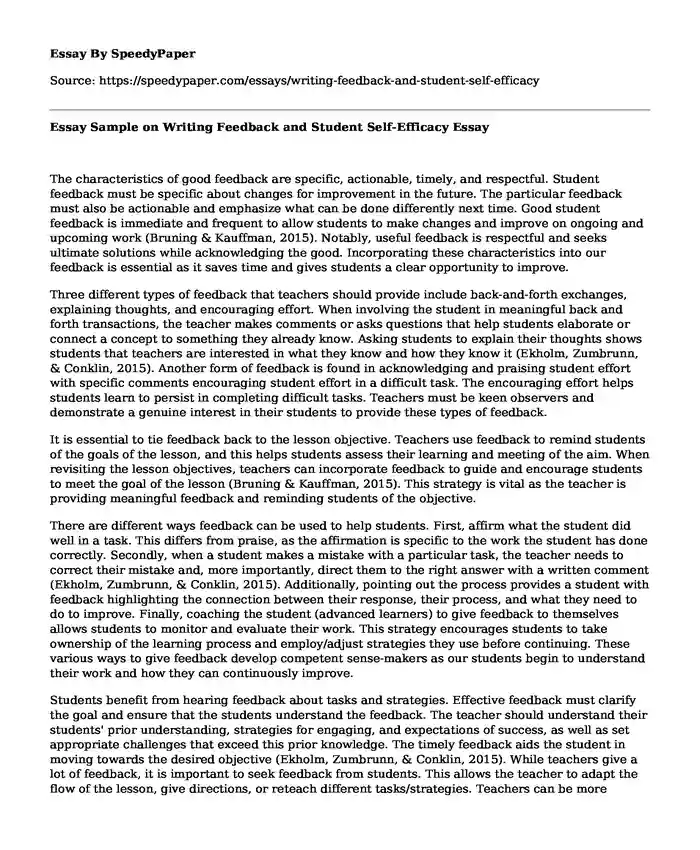
| Type of paper: | Creative writing |
| Categories: | Teaching Students Motivation |
| Pages: | 3 |
| Wordcount: | 630 words |
The characteristics of good feedback are specific, actionable, timely, and respectful. Student feedback must be specific about changes for improvement in the future. The particular feedback must also be actionable and emphasize what can be done differently next time. Good student feedback is immediate and frequent to allow students to make changes and improve on ongoing and upcoming work (Bruning & Kauffman, 2015). Notably, useful feedback is respectful and seeks ultimate solutions while acknowledging the good. Incorporating these characteristics into our feedback is essential as it saves time and gives students a clear opportunity to improve.
Three different types of feedback that teachers should provide include back-and-forth exchanges, explaining thoughts, and encouraging effort. When involving the student in meaningful back and forth transactions, the teacher makes comments or asks questions that help students elaborate or connect a concept to something they already know. Asking students to explain their thoughts shows students that teachers are interested in what they know and how they know it (Ekholm, Zumbrunn, & Conklin, 2015). Another form of feedback is found in acknowledging and praising student effort with specific comments encouraging student effort in a difficult task. The encouraging effort helps students learn to persist in completing difficult tasks. Teachers must be keen observers and demonstrate a genuine interest in their students to provide these types of feedback.
It is essential to tie feedback back to the lesson objective. Teachers use feedback to remind students of the goals of the lesson, and this helps students assess their learning and meeting of the aim. When revisiting the lesson objectives, teachers can incorporate feedback to guide and encourage students to meet the goal of the lesson (Bruning & Kauffman, 2015). This strategy is vital as the teacher is providing meaningful feedback and reminding students of the objective.
There are different ways feedback can be used to help students. First, affirm what the student did well in a task. This differs from praise, as the affirmation is specific to the work the student has done correctly. Secondly, when a student makes a mistake with a particular task, the teacher needs to correct their mistake and, more importantly, direct them to the right answer with a written comment (Ekholm, Zumbrunn, & Conklin, 2015). Additionally, pointing out the process provides a student with feedback highlighting the connection between their response, their process, and what they need to do to improve. Finally, coaching the student (advanced learners) to give feedback to themselves allows students to monitor and evaluate their work. This strategy encourages students to take ownership of the learning process and employ/adjust strategies they use before continuing. These various ways to give feedback develop competent sense-makers as our students begin to understand their work and how they can continuously improve.
Students benefit from hearing feedback about tasks and strategies. Effective feedback must clarify the goal and ensure that the students understand the feedback. The teacher should understand their students' prior understanding, strategies for engaging, and expectations of success, as well as set appropriate challenges that exceed this prior knowledge. The timely feedback aids the student in moving towards the desired objective (Ekholm, Zumbrunn, & Conklin, 2015). While teachers give a lot of feedback, it is important to seek feedback from students. This allows the teacher to adapt the flow of the lesson, give directions, or reteach different tasks/strategies. Teachers can be more effective by listening to students to explain their interpretation of the teacher's feedback by understanding what the student intends to do next.
References
Bruning, R., & Kauffman, D. F. (2015). Self-Efficacy Beliefs and Motivation in Writing Development. Handbook of writing research, 2, 160-173.
Ekholm, E., Zumbrunn, S., & Conklin, S. (2015). The Relation of College Student Self-Efficacy toward Writing and Writing Self-Regulation Aptitude: Writing Feedback Perceptions as a Mediating Variable. Teaching in Higher Education, 20(2), 197-207.
Cite this page
Essay Sample on Writing Feedback and Student Self-Efficacy. (2023, Feb 22). Retrieved from https://speedypaper.com/essays/writing-feedback-and-student-self-efficacy
Request Removal
If you are the original author of this essay and no longer wish to have it published on the SpeedyPaper website, please click below to request its removal:
- Essay Example on Coffee Consumption at Sue's Cafe
- Rock types
- Management Essay Sample on the Strategies for UNHCR
- Free Paper Sample for Students: Taxation Law and Practice
- Free Essay Describing Middle-range Theory in Nursing
- Free Essay: Resume to Finance Job
- Essay Example Analyzing The Old Man and the Sea by Ernest Hemingway
Popular categories




